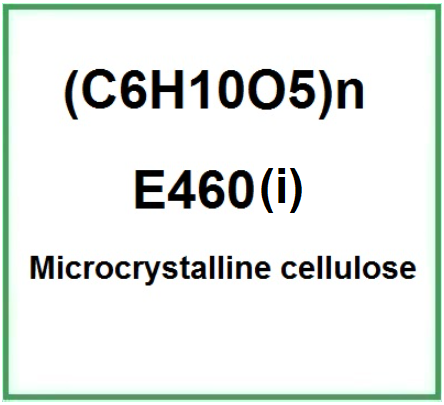![]() E460(i)
E460(i)
Rating : 7
| Evaluation | N. Experts | Evaluation | N. Experts |
|---|---|---|---|
| 1 | 6 | ||
| 2 | 7 | ||
| 3 | 8 | ||
| 4 | 9 | ||
| 5 | 10 |
Cons:
Avoid excessive amounts (1)10 pts from lu22
| Sign up to vote this object, vote his reviews and to contribute to Tiiips.Evaluate | Where is this found? |
| "Descrizione" about E460(i) Review Consensus 10 by lu22 (2319 pt) | 2024-Oct-11 10:02 |
| Read the full Tiiip | (Send your comment) |
E460(i) Microcrystalline Cellulose
Cellulose is an important linear carbohydrate polymer that is biodegradable, biocompatible, renewable, and a low-density compound.
The name describes the structure of the molecule:
- Cellulose. This is an organic compound with the formula (C6H10O5)n, a polysaccharide consisting of a linear chain of several hundred to many thousands of β(1→4) linked D-glucose units. Cellulose is an important structural component of the primary cell wall of green plants, many forms of algae and the oomycetes. Some species of bacteria secrete it to form biofilms.
- Microcrystalline. This term refers to the small, crystalline structure of the material. Microcrystalline materials have crystals that are only visible under a microscope.
The synthesis process takes place in different steps:
- Cellulose extraction. Cellulose is extracted from natural sources such as wood or cotton. In this phase, cellulose is separated from other impurities present in the starting material.
- Alkaline treatment. The extracted cellulose undergoes treatment with an alkaline solution to remove impurities and unwanted components. This helps purify the cellulose.
- Defibration. The purified cellulose is defibrated into very small particles to increase its surface area. This can be done through mechanical processes such as milling or grinding.
- Enzymatic treatment. The cellulose particles are subjected to enzymatic treatment to further reduce the particle size and improve their crystallinity. Enzymes used may include cellulase.
- Washing and purification. The microcrystalline cellulose particles are washed to remove any residues or impurities. This can be done through washing and filtration processes.
- Drying. The microcrystalline cellulose is dried to remove residual moisture and obtain a solid consistency. This can be done through hot or low-temperature drying.
- Milling. After drying, the microcrystalline cellulose is milled into a fine powder to achieve the desired form for the final use.
- Packaging. Finally, the microcrystalline cellulose is packaged in suitable containers for industrial or commercial distribution and use.
It commonly occurs as white crystal powder.
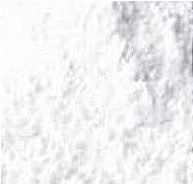
Where it comes from
Through a process of hydrolysis, cellulose can be converted into crystalline Microcellulose from various plants such as palm, bamboo, wood, plants, algae and bacteria.
Applications
Natural cellulose fibers contain crystalline and amorphous domains. Microcrystalline cellulose (MCC) can besynthesized by different processes such as reactive extrusion, enzyme mediated, and acid hydrolysis in that way the amorphous regions are removed and the crystalline domains remain. The hydroxyl groups covering the cellulose surface and orderly arrangement of molecules in MCC allows the cellulose to react well with a variety of materials, including conducting polymers. There are numerous composites of cellulose and its derivatives with synthetic polymers and biopolymers that have been used frequently in different applications such as biomedical applications, sensors and actuators and nanocomposites with good tensile strength (1).
Considering its widespread usage in various fields, such as food, pharmaceutical, medical,cosmetic and polymer composites industries, microcrystalline cellulose (MCC) is becoming impellent due to increasing demand of alternatives to non-renewable and scarce fossil materials. Although it still suffers from some drawbacks, MCC has recently gained more interest owing to its renewability, non-toxicity, economic value, biodegradability, high mechanical properties, high surface area and biocompatibility. New sources, new isolation processes, and new treatments are currently under development to satisfy the increasing demand of producing new types of MCC-based materials on an industrial scale. Therefore, this review assembles the current knowledge on the isolation of MCC from different sources using various procedures, its characterization, and its application in bio-composites. Challenges and future opportunities of MCC-based composites are discussed as well as obstacles remaining for their extensive uses (2).
The present study sheds light on the physical and chemical characteristics of microcrystalline cellulose (MCC) isolated from oil palm fronds (OPF) pulps. It was found that the OPF MCC was identified as cellulose II polymorph, with higher crystallinity index than OPF α-cellulose (CrIOPFMCC: 71%>CrIOPFα-cellulose: 47%). This indicates that the acid hydrolysis allows the production of cellulose that is highly crystalline. BET surface area of OPF MCC was found to be higher than OPF α-cellulose (SBETOPFMCC: 5.64m2g-1>SBETOPFα-cellulose:Qa0 2.04m2g-1), which corroborates their potential as an adsorbent. In batch adsorption studies, it was observed that the experimental data fit well with Langmuir adsorption isotherm in comparison to Freundlich isotherm. The monolayer adsorption capacity (Qa0) of OPF MCC was found to be around 51.811mgg-1 and the experimental data fitted well to pseudo-second-order kinetic model (3).
Recycling of waste cotton fabrics (WCFs) and converting them into high value-added products have not been developed. In this study, a novel and green process was developed for the preparation of microcrystalline cellulose (MCC) from WCFs by the catalytic hydrolysis of phosphotungstic acid (H3PW12O40, HPW). The effects of hydrolysis conditions such as HPW concentration, reaction temperature, reaction time, and solid/liquid ratio were investigated. The optimum process conditions were determined as follows: HPW concentration of 3.47 mmol/L, a solid/liquid ratio of 1:40, reaction temperature of 140 °C, and reaction time of 6 h. The yield of MCC prepared was as high as 83.4% and exhibited better performance than commercial MCC such as a higher crystallinity (85.2%), smaller particle size (20.37 μm), and narrower particle size distribution (72.75%, 8.68-31.1 μm). Furthermore, the HPW could be extracted and recycled easily with diethyl ether for five times and used to prepare MCC with a high yield and crystallinity index (4).
What it is used for and where
Food
Ingredient included in the list of European food additives as E460(i), stabiliser, thickener
Cosmetics
Abrasive agent. It contains abrasive particles to remove stains or biofilm that accumulate on the stratum corneum or teeth. Baking soda, kieselguhr, silica and many others have abrasive properties. Peeling or exfoliating products used in dermatology or cosmetic applications contain abrasive agents in the form of synthetic microspheres, however these microspheres or abrasive particles are not biodegradable and create pollution in aquatic ecosystems.
Absorbent. Absorbs substances dispersed or dissolved in aqueous solutions, water/oil, oil/water.
Anticaking agent. This compound facilitates free flow and prevents aggregation or clumping of substances in a formulation by reducing the tendency of certain particles to stick together.
Bulking agent. It regulates the water content, dilutes other solids, can increase the volume of a product for better flow, acts as a buffer against organic acids, helps to keep the pH of the mixture within a certain level.
Emulsion stabilizer. Emulsions are thermodynamically unstable. Emulsion stabilisers improve the formation and stability of single and double emulsions. It should be noted that in the structure-function relationship, molar mass plays an important role.
Light stabilizer. It prevents light from degrading light-sensitive components and slows down degradation reactions that have already begun. The mechanism is, in a way, similar to antioxidants and the effectiveness depends on the.complexity of the formulation and the density of the product.
Opacifying agent. It is useful into formulations that may be translucent or transparent to make them opaque and less permeable to light.
Viscosity control agent. It controls and adapts viscosity to the required level for optimal chemical and physical stability of the product and dosage in gels, suspensions, emulsions, solutions.
Other uses
- In the pharmaceutical industry, t is inserted into the coating of medicinal tablets with a thickening and stabilizing function.
- This study reports an inexpensive active filler of surface-modified microcrystalline cellulose (MCC) particle for reinforcement of polymer material. A commercial MCC powder with particle size of about 50 μm was mixed with urea and was then irradiated under microwave for the modification. The obtained urea-modified MCC (u-MCC) was able to be dispersed in a chitosan solution without precipitation for over 48 h, which provided a time window for its processing. After the mixture slurry was cast onto glass substrate and then coagulated in a NaOH aqueous solution, a full natural polymer composite film has been prepared. The mechanical properties of the obtained composite films have been carefully measured and discussed. Our results indicate that the mechanical properties reach the highest when the urea-modified MCC is 7 wt% in the composite film: the tensile strength, the breaking elongation, the Young's modulus and the fracture energy are respectively about 2.0, 2.1, 2.4 and 6.0 times those of the pure chitosan film. The reinforcement of the composite material with the u-MCC particles was studied through scanning electron microscopy, Fourier transform infrared spectroscopy and X-ray diffraction analyses, and has been attributed to the strong interaction between the surface-modified MCC particles and the neighboring chitosan chains in the film matrix. Moreover, the water vapor permeability and the transparency of the composite films have been determined to evaluate the potential applications such as gas impervious material and packaging material (5).
- Bio-inspired functionalization of microcrystalline cellulose aerogel with high adsorption performance toward dyes (6).
- In contrast to the conventional methods of improving interface and performances of plant fibre composites through fibre surface modification, this paper reports a novel approach based on the dispersion of microcrystalline cellulose (MCC) in the composite's matrix (7).
- The study describes the development of a vaccine using microcrystalline cellulose (Avicel PH-101) as a delivery carrier of recombinant protein-based antigen against erysipelas (8).
Safety in Use
E460(i) is considered safe for use in food and is approved by various international regulatory bodies such as the European Union and the Food and Drug Administration (FDA) in the United States. No significant side effects are associated with its use at the recommended levels.
Excessive intake of celluloses such as E460(i) may be associated with high risks of cardiovascular diseases (CVD) (9).
Microcrystalline Cellulose studies
Typical optimal characteristics of Microcrystalline Cellulose as a commercial product
| Appearance | White crystalline powder |
| Odor | Inodor |
| Assay | 97.0-102.0% |
| Arsenic | 3mg/kg |
| pH | 5 - 7.5 (100 g/l, H₂O, 20 °C) |
| Solute in water | 0.24% max |
| Loss on drying | 7.0% max |
| Residue on ignition | 0.2% max |
| Heavy metals | 0.0015% max |
| Density | 1.5 g/cm3 (20 °C) |
| Ignition temperature | 232 °C |
| Bulk density | 70 - 400 kg/m3 |
| Storage | +2°C to +30°C. |
| Safety |
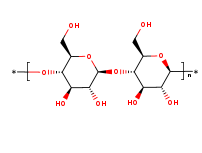 | 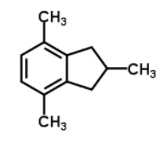 |
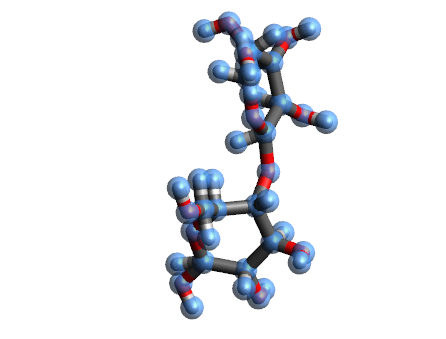 | 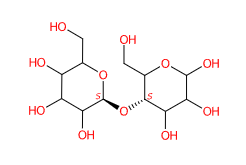 |
- Molecular Formula : C6H10O5 (C₆H₁₀O₅)n (C6H10O5)n=(162.06)n
- Molecular Weight: 342.2965
- CAS : 9004-34-6
- UNII OP1R32D61U
- EC Number: 232-674-9
- DSSTox Substance ID: DTXSID3050492
- MDL number MFCD00081512
- PubChem Substance ID
- InChI Key InChI=1S/C12H22O11/c13-1-3-5(15)6(16)9(19)12(22-3)23-10-4(2-14)21-11(20)8(18)7(10)17/h3-20H,1-2H2/t3?,4?,5?,6?,7?,8?,9?,10-,11?,12+/m1/s1
- SMILES C(C1C(C(C(C(O1)OC2C(OC(C(C2O)O)O)CO)O)O)O)O
- IUPAC (6S)-2-(hydroxymethyl)-6-[(3S)-4,5,6-trihydroxy-2-(hydroxymethyl)oxan-3-yl]oxyoxane-3,4,5-triol
- ChEBI 156274
Synonyms:
- Cellulose powder
References________________________________________________________________
(1) Abdi MM, Md Tahir P, Liyana R, Javahershenas R. A Surfactant Directed Microcrystalline Cellulose/Polyaniline Composite with Enhanced Electrochemical Properties. Molecules. 2018 Sep 26;23(10). pii: E2470. doi: 10.3390/molecules23102470.
(2) Trache D, Hussin MH, Hui Chuin CT, Sabar S, Fazita MR, Taiwo OF, Hassan TM, Haafiz MK Microcrystalline cellulose: Isolation, characterization and bio-composites application-A review. Int J Biol Macromol. 2016 Sep
(3) Hussin MH, Pohan NA, Garba ZN, Kassim MJ, Rahim AA, Brosse N, Yemloul M, Fazita MR, Haafiz MK. Physicochemical of microcrystalline cellulose from oil palm fronds as potential methylene blue adsorbents. Int J Biol Macromol. 2016 Jun
(4) Hou W, Ling C, Shi S, Yan Z. Preparation and characterization of microcrystalline cellulose from waste cotton fabrics by using phosphotungstic acid. Int J Biol Macromol. 2018 Nov 13;123:363-368. doi: 10.1016/j.ijbiomac.2018.11.112
(5) Huang X, Xie F, Xiong X. Surface-modified microcrystalline cellulose for reinforcement of chitosan film. Carbohydr Polym. 2018 Dec 1;201:367-373. doi: 10.1016/j.carbpol.2018.08.085.
(6) Wei X, Huang T, Nie J, Yang JH, Qi XD, Zhou ZW, Wang Y. Bio-inspired functionalization of microcrystalline cellulose aerogel with high adsorption performance toward dyes. Carbohydr Polym. 2018 Oct 15;198:546-555. doi: 10.1016/j.carbpol.2018.06.112.
(7) Pichandi S, Rana S, Parveen S, Fangueiro R. A green approach of improving interface and performance of plant fibre composites using microcrystalline cellulose. Carbohydr Polym. 2018 Oct 1;197:137-146. doi: 10.1016/j.carbpol.2018.05.074. Epub 2018 May 26.
(8) Jeon W, Kim YC, Hong M, Rejinold S, Park K, Yoon I, Yoo S, Lee H, Ahn J. Microcrystalline Cellulose for Delivery of Recombinant Protein-Based Antigen against Erysipelas in Mice. Biomed Res Int. 2018 Jun 11;2018:7670505. doi: 10.1155/2018/7670505. eCollection 2018.
(9) Sellem L, Srour B, Javaux G, Chazelas E, Chassaing B, Viennois E, Debras C, Salamé C, Druesne-Pecollo N, Esseddik Y, de Edelenyi FS, Agaësse C, De Sa A, Lutchia R, Louveau E, Huybrechts I, Pierre F, Coumoul X, Fezeu LK, Julia C, Kesse-Guyot E, Allès B, Galan P, Hercberg S, Deschasaux-Tanguy M, Touvier M. Food additive emulsifiers and risk of cardiovascular disease in the NutriNet-Santé cohort: prospective cohort study. BMJ. 2023 Sep 6;382:e076058. doi: 10.1136/bmj-2023-076058. PMID: 37673430; PMCID: PMC10480690.
| Sign up to vote this object, vote his reviews and to contribute to Tiiips.EvaluateClose | (0 comments) |
Read other Tiiips about this object in __Italiano (1)
Component type: Chemical Main substances: Last update: 2023-04-15 11:15:15 | Chemical Risk: |


